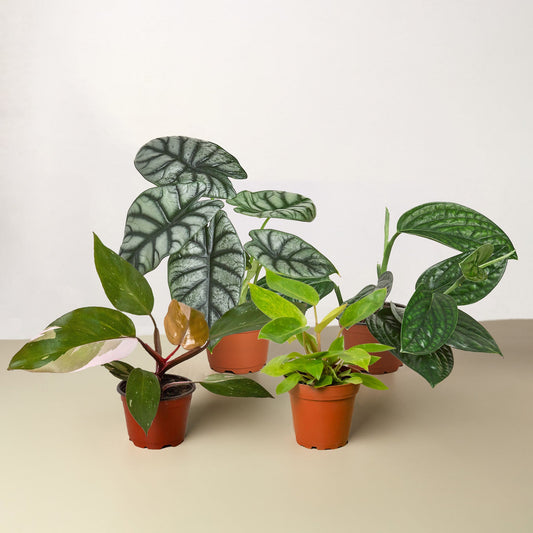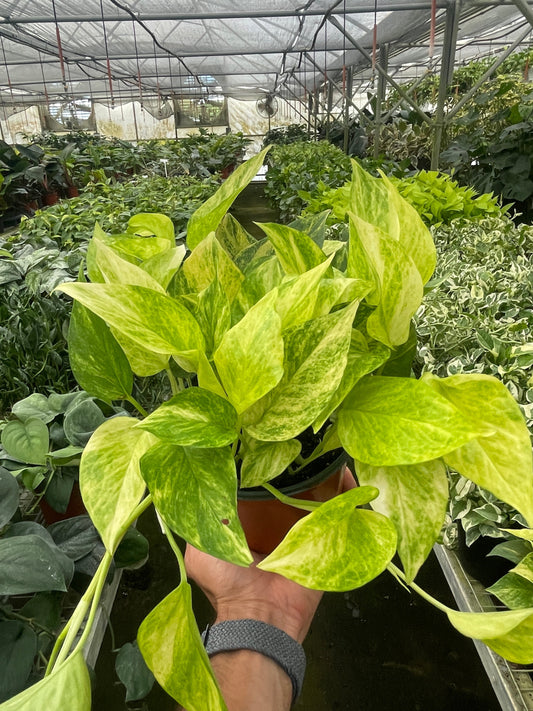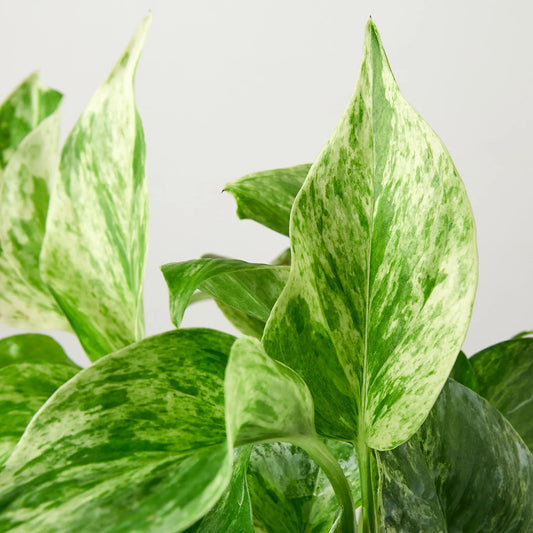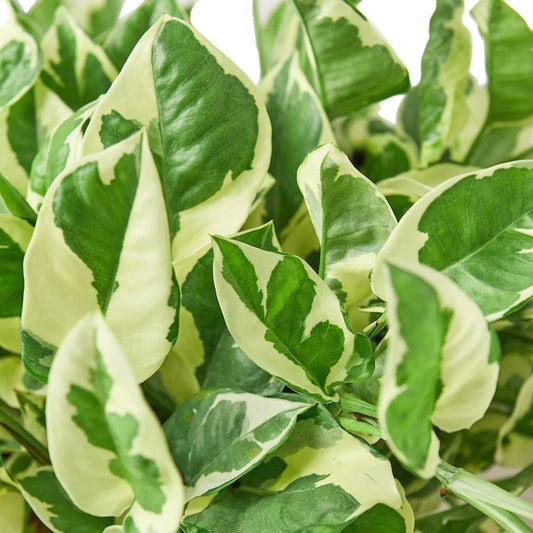Gold Star Dracaena Aerial Roots: Everything You Need to Know
Cafe Planta Team
Houseplants like the Gold Star Dracaena bring a touch of the outdoors inside, adding vibrancy and life to our living spaces. But what happens when your beloved Dracaena starts sprouting aerial roots? Is this a sign of something amiss, or just another quirky trait of this popular houseplant?
In this article, we'll chat about everything you need to know about Gold Star Dracaena aerial roots. From what they are and why they appear, to how you can care for your plant when you spot them, and even how they fit into your interior design. So, grab your watering can, and let's get started!
What Are Aerial Roots?
Aerial roots are a fascinating feature found in many plants, not just the Gold Star Dracaena. Unlike typical roots that grow underground, aerial roots sprout above the soil. They can serve multiple purposes, depending on the plant species. In some plants, these roots help with climbing, while in others, they absorb moisture and nutrients from the air.
For Gold Star Dracaenas, aerial roots might seem like an unexpected addition. These roots generally appear as small, knobby projections along the stem, looking a bit like tiny, greenish or brownish nubs. While they might look strange at first glance, they're usually a natural part of the plant's growth process.
But why does your Dracaena grow them? It often has to do with environmental conditions. High humidity can encourage the growth of aerial roots as the plant adapts to absorb moisture from the air. So, if you live in a humid area or keep your plant in a steamy bathroom, you might notice these quirky roots popping up!
Why Do Gold Star Dracaenas Develop Aerial Roots?
Now that we've established what aerial roots are, let's dig a bit deeper into why your Gold Star Dracaena might develop them. First off, it's important to note that these roots are usually nothing to worry about. They're often just a natural response to the plant's environment.
One of the most common reasons for aerial root development is humidity. As mentioned earlier, Dracaenas, like many tropical plants, love a humid environment. If the air around your plant is particularly moist, the plant might produce aerial roots to help it soak up extra moisture from the air. This is a clever adaptation that helps the plant thrive in its natural habitat, where humidity can be quite high.
Another reason for aerial roots could be related to the plant's quest for stability and support. In the wild, Dracaenas sometimes grow in environments where they need extra anchoring, so they develop aerial roots to help them cling to nearby surfaces. While your indoor plant doesn't need to cling to anything, it might still follow its natural instincts and sprout these roots.
Lastly, aerial roots might appear if your Dracaena is looking for additional nutrients. If the plant feels that it's not getting enough from the soil, it might try to supplement its intake by growing roots that can gather nutrients from the air. This is less common indoors, but it's a possibility, especially if your plant isn't being fertilized regularly.
How to Care for Gold Star Dracaena with Aerial Roots
If your Gold Star Dracaena starts showing off its aerial roots, there's no need to panic. In fact, these roots can be a sign that your plant is thriving. However, there are a few care tips to keep in mind to ensure your Dracaena stays healthy and happy.
- Maintain Humidity: If your Dracaena is sprouting aerial roots because of high humidity, that's a good sign it enjoys these conditions. Consider keeping a humidifier nearby, or misting the plant occasionally to maintain the moisture level it loves.
- Don't Overwater: While humidity is beneficial, overwatering can be detrimental. Ensure your plant's soil drains well to prevent root rot, which can be a bigger problem than the appearance of aerial roots.
- Provide Support: If your plant looks like it needs extra support, consider adding a stake or trellis. This isn't usually necessary for indoor Dracaenas, but if you notice the plant leaning or becoming top-heavy due to its new roots, providing some support can help.
- Fertilize Regularly: If aerial roots are appearing because your plant is seeking extra nutrients, make sure you're providing a balanced fertilizer during the growing season. This will ensure your Dracaena gets all the nutrients it needs without having to forage for them.
By following these simple care tips, you'll help your Dracaena thrive, aerial roots and all. Remember, these roots are usually a natural adaptation and not a sign of distress.
Pruning and Managing Aerial Roots
So, what should you do if you find the aerial roots on your Gold Star Dracaena a bit unsightly, or if they're getting in the way? The good news is that you can manage them with a bit of pruning, but it's important to do it correctly to avoid harming your plant.
First, check the condition of the aerial roots. If they look healthy, there's no pressing need to remove them. However, if they're turning brown or drying out, you might want to snip them off. Use sharp, sterilized scissors or pruning shears to make a clean cut close to the stem. This prevents any potential infection.
It's worth mentioning that pruning aerial roots is a personal choice. Some plant lovers adore the jungle-like appearance these roots provide, while others prefer a tidier look. If you decide to keep the roots, they won't harm your plant, and they might even add a unique aesthetic to your indoor jungle.
For those who do choose to prune, ensure you're not cutting too close to the main stem. Doing so could damage the plant and affect its overall health. Just take it slow and steady, and your Dracaena will continue to thrive.
Incorporating Gold Star Dracaena with Aerial Roots into Your Decor
One of the best things about houseplants is their ability to elevate any space they're in, and Gold Star Dracaena with its whimsical aerial roots is no exception. These roots can add a touch of the exotic to your interior design, creating a focal point that draws the eye.
Consider placing your Dracaena in a spot where its aerial roots can be appreciated. Think about positioning it on a plant stand, allowing the roots to dangle freely, adding a sense of height and drama. If you're feeling adventurous, try grouping your Dracaena with other tropical plants to create an indoor rainforest vibe. The aerial roots can tie the different textures and colors of your plant collection together, offering a cohesive look.
For a minimalist approach, pair your Dracaena with modern, streamlined furniture. The contrast between the plant's natural, wild growth and the clean lines of contemporary decor can create a striking visual balance. You can even use decorative pots that echo the colors of the Dracaena's leaves, subtly pulling the room's design elements together.
However you choose to style your Dracaena, rest assured that its aerial roots will bring a unique touch to your home. Embrace their charm, and let them inspire your creative side!
Common Concerns and Misconceptions
When you first notice aerial roots on your Gold Star Dracaena, it's easy to jump to conclusions. Are these roots a sign of poor health? Do they mean you've been neglecting your plant? Let's put those worries to rest by addressing some common concerns and misconceptions.
First and foremost, aerial roots are usually harmless. They're a natural response to environmental factors and don't necessarily indicate that something's wrong with your plant. In fact, these roots can be a sign that your Dracaena is adapting well to its surroundings.
Some folks worry that aerial roots mean their plant is outgrowing its pot. While it's true that plants can become root-bound, aerial roots are not a direct indication of this. Instead, check the soil for roots growing out of the drainage holes or visibly circling the pot. If you spot these signs, it might be time for repotting, but the aerial roots themselves aren't a cause for immediate concern.
Finally, some plant parents fret that aerial roots make their plant more prone to disease or pests. While any above-ground growth can potentially harbor unwanted guests, a healthy Dracaena is generally quite resilient. Keep your plant clean, avoid overwatering, and monitor for pests regularly to keep it in tip-top shape.
Remember, aerial roots are a natural part of many plants' growth cycles. Embrace them as a unique feature of your Dracaena and enjoy the character they add to your plant.
Repotting Gold Star Dracaena with Aerial Roots
If your Dracaena is thriving and its aerial roots are making it look a bit wild, you might wonder if it's time to repot. Repotting can give your plant more space to grow and refresh its soil, but it's important to handle it with care to avoid disturbing those aerial roots.
When choosing a new pot, aim for one that's just a couple of inches larger in diameter than the current one. This gives the roots room to spread without overwhelming the plant. Make sure the pot has drainage holes to prevent waterlogging, which can lead to root rot.
When you're ready to repot, gently remove the Dracaena from its old pot, being careful not to damage the roots. If any aerial roots have started to grow into the soil, try to keep them intact. Shake off excess soil and inspect the root ball for any signs of rot or disease.
Add fresh potting mix to the new pot, place the Dracaena in, and fill in around the sides with more soil. Water the plant thoroughly after repotting to help it settle into its new home. Keep in mind that your plant might take a little time to adjust, so don't worry if it looks a bit droopy at first.
Repotting can be a great opportunity to refresh your plant's environment and give those aerial roots a chance to shine. With a bit of care, your Dracaena will continue to thrive and add beauty to your home.
Propagation: Aerial Roots and New Plants
Have you ever thought about propagating your Gold Star Dracaena? Those aerial roots might just give you the perfect opportunity to create new plants from your existing one. While not as common as other propagation methods, using aerial roots can be an exciting way to expand your indoor jungle.
To propagate using aerial roots, you'll need a healthy section of the plant that includes both a stem and some aerial roots. Carefully cut a segment of the stem, ensuring it has at least one set of aerial roots attached. This will give your new plant a head start when it comes to absorbing moisture and nutrients.
Place the cut section in water or moist soil, ensuring the aerial roots are in contact with the growing medium. With a bit of patience, you'll notice new growth as the plant establishes itself. Once roots have developed, you can transfer the new plant to its own pot, and voilà, you've successfully propagated your Dracaena!
Propagation can be a rewarding way to share your love of plants with friends or increase your own collection. Those aerial roots, though sometimes unexpected, can be a fantastic resource for growing new plant companions.
Embracing the Quirks of Your Gold Star Dracaena
At the end of the day, aerial roots are just another delightful quirk of owning a Gold Star Dracaena. These unique features add character to your plant and can even offer insights into its health and environmental preferences.
Remember, owning houseplants is as much about enjoying their beauty as it is about understanding their needs. By learning about aerial roots and how to care for them, you're becoming more in tune with your plant's signals and creating a nurturing environment for it to thrive.
So, embrace the quirks of your Dracaena, and let those aerial roots be a conversation starter. They're a testament to your plant's adaptability and resilience, and they make your Dracaena uniquely yours.
Final Thoughts
We've covered a lot about Gold Star Dracaena aerial roots, from their causes and care to their role in your home's decor. These curious roots are a testament to your plant's adaptability and can add a special touch to your indoor space.
At Cafe Planta, we love helping plant enthusiasts with their green companions. Whether it’s finding the right houseplant, plant care accessories, or even plant-themed apparel, we’re here for you. If you have questions, feel free to email us or send a DM on Instagram. We’re excited to share our passion for plants and help you create a thriving indoor garden.



















